
Corporate Learning is a Window into Your Organisation’s D&I Soul
Three golden rules for companies seeking to put diversity on their training agenda
Let’s say a company comes to us for help with incorporating diversity and inclusion (D&I) into the learning experience of its employees. Up until fairly recently, the first question we would ask would be, are you looking for training content that appeals to a diverse target audience, or training content that deals with the subject of diversity?
But things have changed over the past couple of years, as Philipp Schossau, Senior Instructional Designer here at imc, explains: “Making training courses diverse in terms of both content and visual appearance is now a standard requirement, irrespective of the subject matter. Diversity training, on the other hand, has its own special requirements – most notably a clear stance on the part of the client.”
Diversity in e-learning is clearly growing in importance. So, in this article, we have put together a summary of key recommendations for companies seeking to incorporate diversity into their learning experience.

All a matter of perspective? Tips for implementing diversity in training content
Prospective employees want to be able to see what a company’s position on D&I is, and how the company is championing the D&I cause. So, whatever the subject matter, company training courses should be diverse and gender-neutral in design. Here are three golden rules for making training courses diverse and inclusive:
Culturally diverse characters:
Whenever human personas or mentors feature in a training course they should reflect a certain degree of cultural diversity. If there are not enough personas to demonstrate sufficient diversity, then it is possible to use fictional characters – avatars – that have no particular cultural background.

imc Biz Quiz
Diverse gender identities:
Needless to say, learning content should aim to reflect and include all gender identities. It’s not enough to merely employ terms like “male”, “female”, and “gender-diverse”. The aim, rather, should also be to break down conventional gender roles and gender stereotypes. Our learning experts therefore always endeavour to keep their design concepts free of these outdated roles and clichés.

INFO:
We’re currently working on a diversity avatar creator. Before taking part in a training course, each user will be able to build an avatar that looks however they want it to, regardless of cultural background or gender role.
Gender-neutral language:
This often depends on the requirements articulated by the company in question. However, we strongly recommend the consistent use of inclusive language across all training content.

in German you can use "*" to create gender-neutral language

GOOD TO KNOW
Authoring tools like imc Express automatically offer a range of output options and simplify the process of creating diverse and inclusive training content. With imcExpress, this process is controlled in the background via AI.
Attitude is a prerequisite for special diversity trainings
The role that D&I management plays in a company is rooted in the corporate culture. This has a direct impact on a company's learning culture. Those who want to implement special diversity and inclusion training into the learning experience of their employees must have a clear stance on it. For this reason, companies should always be clear about the goal of a training before designing the content.
To sensitise the learning audience to diversity issues and communicate facts about D&I, we recommend scenario-based learning. Scenario-based learning uses real-life examples and situations. The closer the learning scenarios are to real-life situations, the more relatable the taught (behaviour) rules will be for the learners. Sensitisation can be further improved by using diverse personas to make learners aware of different or new perspectives.
Ready when you are
Things are changing, and organisations are already taking steps to make their training courses more diverse and to raise awareness of D&I. But many companies are still holding back for fear of doing something wrong. That’s why it’s critical to support D&I with effective corporate communication and drive genuine cultural change. In other words, when it comes to D&I, companies need to be bold and have courage of their convictions.

“The more global the company, the more likely that it’s already sensitised to diversity issues and will take the initiative and articulate diversity requirements for our projects,” said imc project management officer Kenneth Littlepage, Project Management Officer Business Consulting at imc in a previous interview on D&I. “Locally focused companies, on the other hand, tend not to be so sensitised, so it’s up to us to ask questions.”
However a company might choose to approach it, diversity is a topic that’s here to stay, especially for today’s younger generation. Warm fuzzy words in the corporate vision statement are all well and good, but they won’t carry much weight if the company is a monoculture of white men in suits or hides behind disclaimers to the effect that “the use of he and his is solely for ease of reading and refers to all genders equally”. If you want diverse people in your company, you actually have to make them feel included.

Rapid Content Development
We want things now: fast food, coffee to go, messenger services, online shopping … we no longer have time. Companies have also clocked onto this trend, and want to stay up to date with their training courses.

Gamification takes corporate learning to a new level
The fact that Game Based Learning works as a motivational booster for e-learning is already rooted in childhood. We have summarized the most common types of games and practical examples for you.
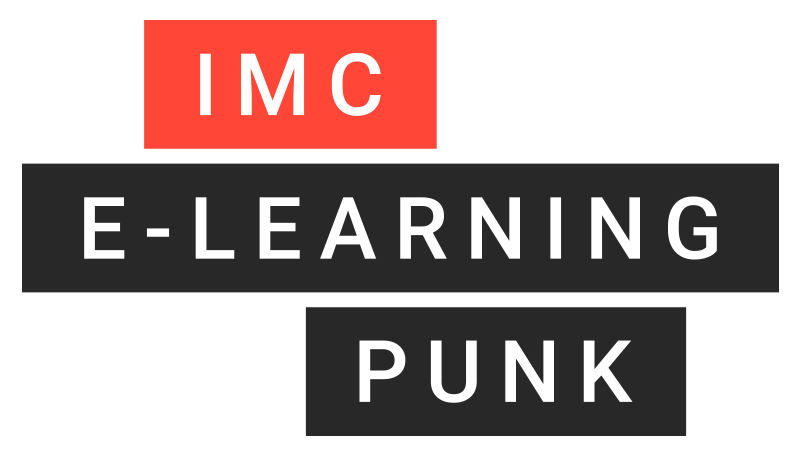
Contact person
I joined the imc newsroom team in 2021. As a journalist my heart beats for content and storytelling.
I’m excited to figure out how e-learing and digitization affect the future of work. My task is to create content to talk about and I’m always looking for trends.
Privately I love to travel and eat Tapas.
Topics: E-Learning Trends, Corporate Social Responsibility, Press and Influencer Relations

Tips for Using 2D Maps in e-learning
The many advantages of putting learning content into a map structure
Learning content should be inspiring, if not utterly captivating. Ideally, it should be branded and look cool. And it needs to be engaging for the video gamer generation, without alienating more conventional learners. That’s a lot of boxes for modern learning experiences to tick.
Consequently, many companies and organisations are turning to map-based training. Even so, it’s a fairly new area, and the e-learning applications of maps may not be immediately obvious, despite the ubiquity of Google Maps.
That’s why we have put together this article. It explains the difference between 2D and 3D maps and illustrates the structure and advantages of 2D map-based training.

Differences between 2D and 3D maps
Arguably the most important difference between 2D and 3D maps is the browser performance required. 3D maps are rendered live in the browser, so they require more computing power and a very stable network or internet connection. The upside is that 3D maps allow dynamic perspectives: users can switch perspectives within the map.
A 2D map does not allow dynamic perspectives, but the viewer can create the impression of changing perspective by moving relative to the map. This 2D principle is employed in many strategy games, for example. The map is based on images in which it is not possible to change perspectives. The advantage is that fairly large story/learning worlds can be shown without requiring a lot of browser performance.

2D animation
2D does not necessarily mean static. Within a 2D world, it is possible to have individual elements that are animated and dynamic. This is called 2D animation, and it lends life and vibrancy to 2D maps. It is even possible to integrate 3D graphics into 2D maps.
The introduction: arriving on the map
As with most learning experiences, it’s a good idea to start with an introduction. The introduction can appear or pop up on the map in the form of a chat window or a specially created page that briefly outlines the storyline and subject matter of the training session. It is advantageous here to explicitly tell the learner what the training task will involve, and what their objectives are. The benefit of showing an introduction directly on the map at the outset is that the learner does not need to leave the learning world and therefore does not lose focus.
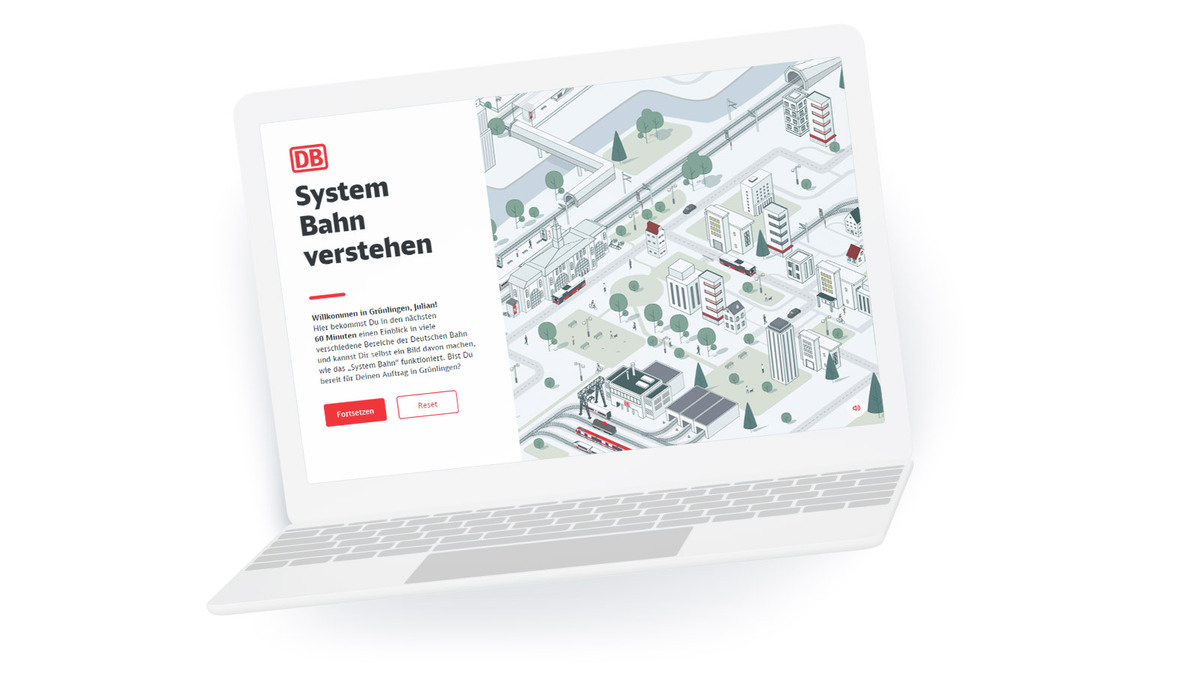
2D Map Training Deutsche Bahn
The main narrative: read the map
It is vital that the main part of the session is self-explanatory. This means the map must be intuitive to use. A certain degree of in-map guidance can be achieved by unlocking individual tasks step by step. That way, learners intuitively know the correct task order, without having to be explicitly told. Crucially, this approach allows learners to discover the learning content for themselves, i.e., exploratively. The navigation leads via the 2D map to various locations that the learner can ‘visit’. An example would be where the map shows a building that the learner can click on and enter in order to progress to the next task or access a learning nugget.
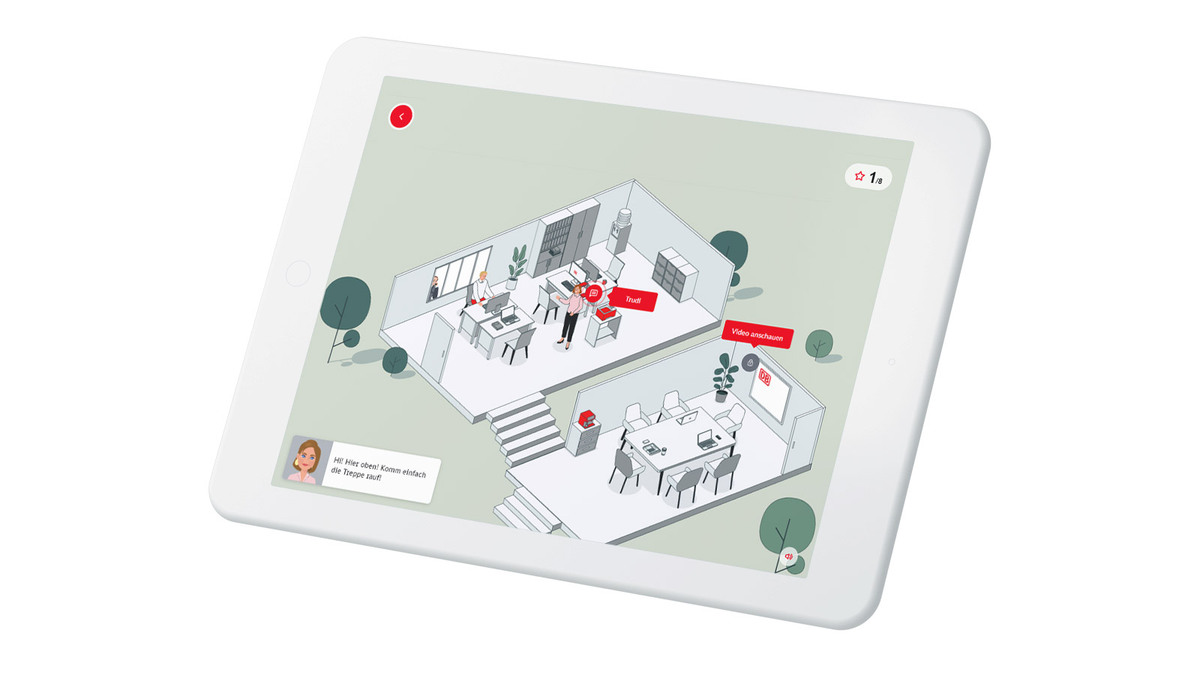
2D Map-Training Deutsche Bahn
Interstitial and achievement screens can be used to lend further structure to the main narrative by appearing as pop-ups overlaying the map. They can provide orientation by showing learners their next tasks, highlighting their progress, or making them aware of further options. The whole learning experience can be made even clearer by adding jump labels to individual locations on the map. These can be used to help the learner navigate from tasks to their associated learning content.
GOOD TO KNOW
Learners should not need to leave the map (the learning world) at any point. Everything they need in order to achieve their objectives should be contained within the map. This can be achieved, for example, by using chat windows that open directly on the map, or by showing learning nuggets, content items and hints as overlays on the map.
The conclusion: leave the map
In 2D maps, just as in other learning settings, it is important to clearly mark the conclusion of learning units and tasks so that learners know they have successfully completed the section in question or indeed the entire training session. There are many different ways of doing this. The key is to ensure the method chosen fits with the training session’s overall storyline. For example, you can use a list of checkpoints which is then displayed at the end with all tasks checked off. Or you can show a notification in the chat window.

Success message at the end of a training session
Questions?
Can a map-based training session also be short?
To retain the map’s explorative dimension while at the same time creating a training session that can be completed within a short space of time, you can reduce the amount of learning content, streamline the user experience, or confine exploration strictly to key locations on the map. The main thing is to maintain excitement while keeping the learning purposeful.
How gamified can a map-based training session be?
The primary focus must be on the learner experience, so the map should not contain any unnecessary actions or locations.
Surely map-based training sessions are very labour-intensive to produce?
Not necessarily. The total overhead can actually be relatively low, as the world created by a 2D map makes a relatively large contribution to creating an exciting learning experience. It is possible to reduce the design overhead that goes into learning nuggets/subpages by integrating them into a 2D map.
But isn’t that really expensive?
The 2D map format does not necessarily require more design work by our experts, so it is a very good alternative to 3D maps, even for limited budgets.
What are the other advantages over 3D maps?
Good performance, low overhead, faster page loading.

Rapid Content Development
We want things now: fast food, coffee to go, messenger services, online shopping … we no longer have time. Companies have also clocked onto this trend, and want to stay up to date with their training courses.

Gamification takes corporate learning to a new level
The fact that Game Based Learning works as a motivational booster for e-learning is already rooted in childhood. We have summarized the most common types of games and practical examples for you.

Contact person
I joined the imc newsroom team in 2021. As a journalist my heart beats for content and storytelling.
I’m excited to figure out how e-learing and digitization affect the future of work. My task is to create content to talk about and I’m always looking for trends.
Privately I love to travel and eat Tapas.
Topics: E-Learning Trends, Corporate Social Responsibility, Press and Influencer Relations

This year’s e-learning content trends
Interview with Falk Hegewald, Director E-Learning at imc
Out with the old, in with the new. A new year brings new content trends that nobody involved in corporate learning can afford to ignore. Together with Falk Hegewald, Director E-Learning at imc, we are taking a look at the coming year’s crucial topics for companies.

INFO
Falk Hegewald started out in design: He studied graphic design and followed that up with game design. But when imc introduced him to the e-learning sector nine years ago, he decided to stay put. “Back then, I was attracted to the idea of creating something new in this world of e-learning. It was all still very 1990s in those days,” says Hegewald. At imc, he is responsible for custom and off-the-shelf content worldwide.

Now, we’re really getting started: 3D, VR and Metaverse
Falk Hegewald is confident that the upcoming big changes are here to stay – well beyond 2022. Many major corporations are driving the development of virtual reality and metaverse. Nike recently acquired a design studio that “produces” NFTs and virtual running shoes.
“The key driver for metaverse is to create a world where you can play. However, that world will also feature workspaces. We are already entering that world with virtual meeting rooms,” Hegewald explains. “At imc, we are taking that as an incentive to develop the 3D aspects of our content to gain a head start in the creation of such digital worlds and environments.”

INFO
Metaverse:
Metaverse describes an immense collective virtual space formed when real and virtual worlds merge. A metaverse comprises both open and closed platforms. Companies can create their own worlds as well as digital products, and even sell them there – just like in the real world.
Engaging content and adaptive learning
This year will also see a strong focus on more engaging content that both motivates and captivates the learner. Not everything needs to be a game, Falk Hegewald claims: “You can also use novel engaging activities and formats. There is already demand for inspiring training, as companies have realised that they need to get more buy-in from their employees. As a premium content provider, we can deliver that.”
Adaptive learning will also be very relevant for content in the year ahead. In the past, the focus was on learning management systems featuring intelligent interfaces that facilitate appropriate distribution of training courses. Now, we are moving towards skill management through content. Falk Hegewald is confident that adaptive e-learning content will be in demand this year. “You rarely need everyone to learn everything. Employees with different levels of knowledge attend the same training course. Testing prior knowledge and leveraging suitable tools to assign content becomes a whole lot easier if the content is adaptive, too.”

Adaptive learning
Premium off-the-shelf content will be big next year
Last year, Falk Hegewald was particularly excited about the "Cyber Crime Time"awareness game, which deals with IT security issues by letting the learner take on the role of a hacker. Step by step, they learn the most common cyber-attacks first hand. “This goes well beyond your typical off-the-shelf content, be that from us or from our competitors. We wanted to create something that gets the employees’ attention.”
Yet, that was only the first step: This year, Cyber Crime Time will be expanded to include additional training courses and learning nuggets – smaller learning units. “Our aim is to create an entire training world for IT security so Cyber Crime Time remains exciting for our customers,” Hegewald explains.
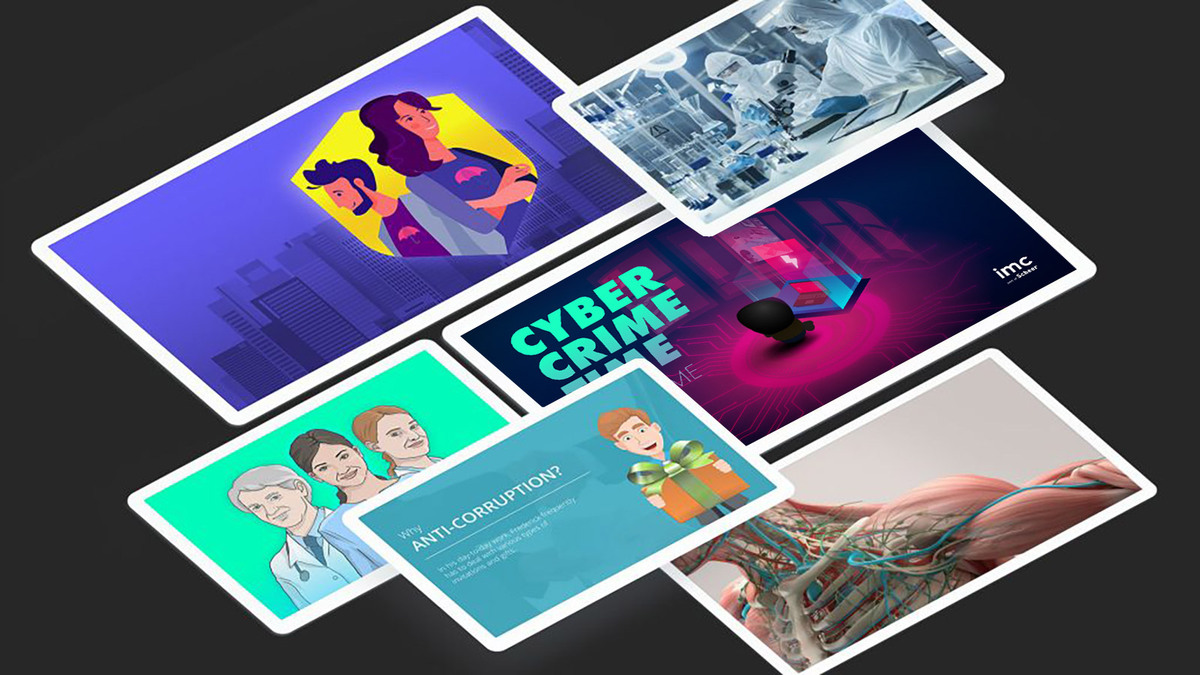
Premium Standard Content of imc
Falk Hegewald’s department also had their hands full designing custom content for corporate clients throughout 2021: They created a wide range of complex learning content, as well as complete digital learning journeys – covering everything from onboarding through corporate strategy to exciting sales training for customers like Jägermeister. “Generally speaking, many of our customers were more daring in their content design and presentation this past year. We love that trend and believe there is room for even bolder creative moves in the stories and the design,” says Hegewald.

The Jägermeister Master Academy
The war for talents goes into the next round
Companies are forever looking to attract talents and retain them long-term. The right onboarding and employee development are playing an ever-greater role in this quest.
To feed into that ambition, it is important that professional development content is up-to-date and dynamic. Falk Hegewald explains: “Young talents joining the job market are used to a different pace, they use media in a totally different way. It can become very challenging for a company to keep them engaged.”
That is why a key aspect will be to make onboarding and professional development courses accessible on all devices, enabling the latest generation of employees to learn anytime and anywhere.
As Head of the Division, Falk Hegewald always gets excited when new colleagues bring fresh and interesting ideas, as is often the case when they join straight out of university. “This type of inspiration is vital. As a content department, we always need to keep an open mind for new ideas.”

As Content Director, what are you looking forward to this year?
“Exciting new customers and new client projects. Personally, I would really like to visit the other imc locations again and meet the employees I have not yet had any personal contact with.”
Well, here in Saarbrücken, we are looking forward to meeting you, Falk!

Gamification takes corporate learning to a new level
The fact that game-based learning works as a motivational booster for e-learning is already anchored in childhood. We have summarised the most common types of games and practical examples of possible applications for you.
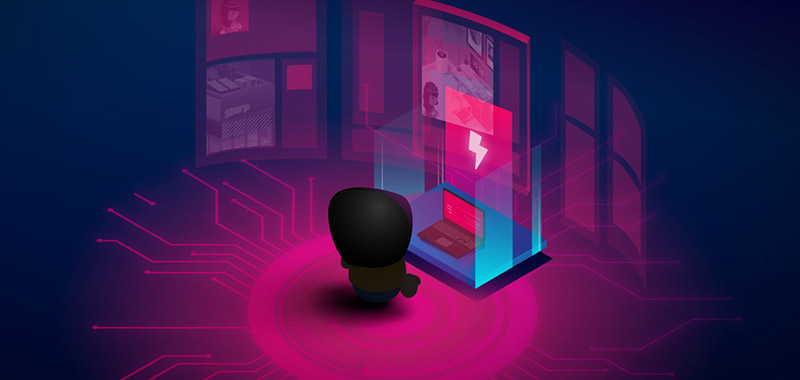
Awareness trainings are the key to success in the prevention of cyber attacks
Cybercrime is on the rise. It is no longer just a handful of criminal hackers who want our data and, unfortunately, our money. Learn in this article how awareness training can improve your IT security.

Contact person
I joined the imc newsroom team in 2021. As a journalist my heart beats for content and storytelling.
I’m excited to figure out how e-learing and digitization affect the future of work. My task is to create content to talk about and I’m always looking for trends.
Privately I love to travel and eat Tapas.
Topics: E-Learning Trends, Corporate Social Responsibility, Press and Influencer Relations

The Ultimate eLearning Jargon Glossary 2024
LMS, LXP, SCORM, WBT, EPSS, NGLE, CBT, ITS!? Lost in a world of elearning terms and abbreviations?
Digital learning is teeming with cryptic terms, many of which are not at all self-explanatory and have various, equally-confusing alternatives.
In this A to Z, we shed some light on the subject and have compiled a list of the most important terms and abbreviations in the field of e-learning in 2024.
Jump to a relevant section or scroll on to browse…
Adaptive Learning Systems (aka Intelligent Tutoring Systems / ITS)
Adaptive learning systems gather data on the learner's activities and use this to adapt the learning journey to the individual’s observed needs. Using algorithms, the system will deliver image based content to a visual learner and interactive content to a communicative learner, or advanced content to a learner showing expertise in the subject area.
API
The term API stands for Application Programming Interface. This is a tool that acts as a bridge between two software platforms, allowing them to communicate data with one another.
In the context of e-learning, an API can be hugely valuable by allowing your learning platform to communicate learner data with related business systems, such as your HR software or collaboration tools like Microsoft Teams. This saves time by reducing the need to duplicate the management of employee data across multiple platforms.
Authoring Tool
An authoring tool is software for making it easier to create e-learning content. This could include interactive applications with which text, graphics, sound and interactivity can be combined to form a piece of content. Authoring tools can be used to create simple presentations or WBT (web-based training), or with an advanced tool - a full interactive module. No programming knowledge is required for using an authoring tool.
Learn more about our own authoring tools:
Blended Learning
Blended learning uses a combination of online and in person training to deliver training. The term often also refers to a blend of instructional methods, pedagogical approaches and technologies.
More about blended learning advice on our blog.
Cloud Hosting
Cloud hosting is the housing of digital resources or applications across multiple servers, often across multiple data centres or even countries. This can help to reduce the risk of downtime from a single machine failure.
Also known as cloud-based hosting, this can be a highly effective way for organisations - especially large, multi-site operations - to ensure speed of resource delivery regardless of location, and to scale as needed without the potential limitation of a single machine.
Conversational Learning (aka Conversational Interfaces)
Conversational learning interfaces utilise the basic concepts of social learning to create an interactive learning experience. The chatbot guides the user through the learning material with a question and answer conversation between user and bot.
Emoji's are a key part of conversational learning. Used as a replacement for body language, emoji's provide the learner with the non-verbal cues that are missing from digital training tools.
Custom content (aka bespoke content)
Custom elearning content is developed specifically for the needs of any individual client, in order to best meet their current and future training needs.
The alternative is ‘off the shelf content’, which is typically lower cost and used to deliver quick, compliance-based training. This can be good for ‘tick-box’ kind of training in areas such as basic health and safety awareness.
However, if you’re looking to use e-learning to engage learners and drive performance in the context of your business, then custom content will tend to be much more effective.
Learn about the custom elearning content development services we offer at imc.
Digitisation, Digitalisation and Digital Transformation
Digitisation is simply the transfer of assets from analogue to digital. In the context of learning, this is often taking paper based training materials or face to face classroom delivery, and creating online learning media, which is often housed in an LMS.
Digitalisation is the tactical use of digital tools to improve business processes. For example, this could be analysis of employee or team data within a performance management system (or even just a spreadsheet), in order to identify skills gaps or improvements to training materials. Digitalisation could go as far as changing a business model - for example, a physical goods store moving to ecommerce or a training company switching to selling courses online.
Digital Transformation is the broadest move that happens as a strategic shift orchestrated by the highest level of management. It is a long-term, highly coordinated series of digitalisation projects that may need to overlap and interact with each other.
Digital Transformation can be a powerful modernisation of an organisation that enables it to find new efficiencies, adopt the latest and future technologies, and literally change the organisational culture.
e-Learning
This is what imc Learning is all about - the term e-learning stands for ‘electronic learning’. Also known as elearning without the hyphen and digital learning, the word dates back to the days of installing training software to your desktop computer from a CD-ROM.
Now though, e-learning tends to be seen as synonymous with online learning and mobile learning that’s available anywhere and any time.
Electronic Performance Support System (EPSS)
An EPSS supports just-in-time (JIT) learning. In contrast to formal learning, this takes place at the point of need. EPSS is typically deployed to support a piece of software and can either guide a user through a process or act as a JIT tool, on hand to provide support when needed. The user gains independence and confidence by efficiently learning new systems and processes without the aid of expert trainers.
Extended Enterprise
An extended enterprise means a company that needs to train, for example, franchisees, external service providers, brokers, their supply chain etc. Such training can be tackled strategically and efficiently by creating learning portals, customised for each type of audience, built into your LMS.
Game-Based Learning
The term Game-Based Learning refers to learning experiences that are delivered through the use of a game. A learning environment must be created that is attractive for the user, in which he or she can develop through positive, entertaining learning experiences.
More Game-Based Learning advice on our blog.
Gamification
This term refers to player motivation principles, such as rewards, to drive learner engagement. Gamification elements within training could be scores that are displayed to the learners and allow them to compare themselves with other players. Further gamification elements are badges and badges, which are awarded after completed tasks.
Gamification principles for motivation can be incorporated into training without the learning experience actually involving a game.
Instructional Design
This is a skill and process that combines foundational principles in learning psychology with the latest available technologies to design content for the best possible learning experience. Trends in recent years have moved towards learner engagement, as well as the effectiveness of content, helping people want to follow the training materials.
Multimedia content options, such as video that is now more accessible with ubiquitous, fast internet access, and principles such as gamification and games-based learning, are now key elements of the instructional design toolkit.
Modern e-learning software, such as our own authoring tools, allow L&D professionals and subject matter experts with no formal industrial design training to create effective learning content.
Interactive Learning
Interactive learning requires a greater level of learner involvement than the stereotypical, ‘click next’ e-learning experience. Interactive training content has been shown to bring better learning outcomes than a passive learner experience, as it tends to be more engaging and forces the learner to process information and put their learning into action.
Interactive Video
Interactive videos are films that allow learners to decide for themselves what they want to see next. The learner is thus not only a passive viewer, but actively determines what he or she sees and learns.
Learning Experience Platform (LXP)
The LXP is a relatively new concept that takes e-learning beyond a top-down, employer-led platform into being a more immersive environment where employees can explore what to learn next. This allows them to proactively develop their own knowledge and skills.
Many LXPs take principles of context exploration and recommendation engines from the likes of Netflix. They can be a key tool for large companies to encourage a culture of learning.
Learning Nuggets
A learning nugget is a short learning unit or a building block or a mini module in e-learning that usually lasts no longer than five minutes. The term is often used in connection with Micro-Learning.
Learning Management System (LMS)
A Learning Management System, (LMS for short) is software used to digitally host, manage and track learning content, which is typically assigned by tutors to their learners.
More about Learning Management Systems on our Learning Suite page.
Learning Content Management System (LCMS)
A Learning Content Management System (LCMS) is software that enables the creation, storage and management of reusable learning objects. It also enables web-based learning to be organised and maintained by multiple authors. An LCMS combines the functionality of an LMS and a content management system (CMS).
Learning Record Store (LRS)
A Learning Record Store is connected to an xAPI or Tin Cab and collects, stores and retrieves data and learning activities. An LRS can be integrated into an existing LMS.
Learning System Suite
The concept of the Learning System Suite is a combination of an LMS and LXP, as well as a NGLE.
It provides all the top-down training delivery and assessment capabilities associated with a Learning Management System (LMS) for the essentials of onboarding and compliance, combined with the intuitive and engaging environment of a Learning Experience Platform (LXP) and the broader ongoing training, collaboration and interoperability you might consider to be a Next Generation Digital Learning Environment (NGDLE) (or NGLE).
The imc Learning Suite is built for exactly this purpose - a solution for learning management, experience and performance all in one place, while integrating seamlessly into your existing tech stack.
Micro-Learning
Learning content is divided into small units or building blocks for the user to access as individual elements at any time. This flexible approach is also often termed as 'learning nuggets'.
Mobile Learning (M-Learning)
Mobile Learning refers to training accessed through mobile devices. This makes the learning experience more flexible and more independent of time and location.
Mobile Learning modules are typically designed primarily for a smaller screen size, especially phones, enabling any time, anywhere learning. This requires streamlined content that is less taxing on bandwidth, and a different approach to user navigation.
More about Mobile Learning on our blog.
MOOC
A MOOC (a Massive Open Online Course) is an online course aimed at a large number of participants and is usually free of charge. Pioneers of this format are Stanford University, the Massachusetts Institute of Technology (MIT) and Harvard University.
Multi-tenancy LMS
In the field of software, the term multi-tenancy refers to a single application (so in our context, the LMS) shared by multiple user groups who each experience their own, individualised learning environment. This means that different user groups can have different learning portals (each with its own entry portal, its own features, user rights, content, look & feel, etc.), while the system is centrally managed through a single LMS.
This can greatly reduce the cost and time needed to adapt the training experience for different teams, partner organisations, or even customers.
Read more about multi-tenancy LMS solutions in our in-depth article on the topic.
Next Generation Digital Learning Environment (NGDLE)
L&D professionals and industry commentators have been bemoaning the limitations of learning management systems and predicting their imminent death almost since they were invented. One of the key complaints is their closed nature that requires a great deal of additional administration alongside other business and HR systems.
The idea of the Next Generation Digital Learning Environment or NGDLE is that it opens up a learning and people performance ecosystem of tools with open standards and principles, perhaps with single sign on (SSO), which will greatly reduce the siloing of learning assessment, collaboration, feedback and general communication.
Some people drop the ‘Digital’ as a given, giving us NGLE.
Our own imc Learning Suite is an example of such an integrated solution that plays nicely with other popular business tech solutions.
On-site Hosting (aka on-premise hosting)
In contrast to cloud hosting where data can be stored on multiple servers, and possibly even across multiple territories, on-site hosting will house data at a single client location.
While data security has generally improved over the years and many organisations have moved entirely over to the cloud, on-site hosting can still be appropriate for some organisations where security is of extra concern, and / or to ensure compliance with specific industry or local regulations.
The downside of on-site / on-premise hosting compared to cloud tends to be reduced scalability as resource needs grow or the economies of scale associated with a company maintaining thousands of machines at one or more data centres, rather than a small number on-site. However, this is not a concern for some single-site organisations.
On-the-Job-Training (OJT)
On the Job Training refers to learning that takes place alongside activities at the workplace, and usually under the guidance of a colleague, coach or mentor or also through an EPSS. In colloquial terms, "learning by doing" refers to this type of training.
Performance Management System
A performance management system enables the ongoing, regular monitoring of employees against KPIs and individual targets. These targets and expectations will be set to support collective contribution towards the wider organisational strategy.
A good performance management system will include learning resources to help support individuals and give them data on their own performance, while providing a management dashboard so that L&D and HR teams can identify an issues, in order to offer additional support or intervention where needed.
The imc Learning Suite incorporates the functionalities of a Performance Management System in the LMS. With its extensive Learning Analytics modules, the imc Learning Suite provides both learners and tutors as well as managers with clear dashboards regarding the learner's progress and performance.
Predictive Analytics
The leading modern learning management systems can aid in the use of learner data to identify potential training requirements of individuals or certain groups.
Predictive analytics is a foundation of adaptive learning systems and learning experience platforms.
REST API
API (Application Program Interface) as explained above is a general set of protocols that enables various software to interact and communicate data between each other. REST API or RESTful API (Representational State Transfer) is a subset of this that deals specifically with web applications and is mostly used to handle HTTP requests.
SCIM
The abbreviation SCIM stands for System for Cross-domain Identity Management and is one of the open standards for managing user information across platforms. In the context of L&D and HR, it can greatly streamline IT tasks and reduce admin time when using cloud-based apps and services, as it allows your IT team to automate many repetitive tasks, such as employee details and learning requirements.
SCORM
The abbreviation SCORM stands for "Sharable Content Object Reference Model" which references the digital packaging of e-learning courses. Through this format, SCORM courses can be imported and launched through any SCORM compliant platform. Industry standard LMS all include SCORM players.
Serious Game (related terms: Adventure Game or Learning Game)
Serious games are not exclusively for entertainment purposes, but instead convey knowledge or skills through playful actions. See also: Gamification and Game-based Learning which aim to engage and motivate learners through adventures and competition.
Social Learning
Social Learning promotes an interaction between learners through sharing learning experiences. e-Learning can include social elements through comment functions, social media postings, instant messages, forums, wikis, video chats, etc. which can typically be integrated with modern LMS. In addition, virtual communities can be set up to exchange ideas, knowledge and new contributions.
More about Social Learning on our blog.
Validated Learning Management System (VLMS)
Many companies – for instance, in the food, pharmaceutical or medical sector – need to meet strict regulatory requirements such as FDA Title 21 CFR Part 11. These requirements include that all processes leading up to the production of a product have to be documented and verified at any time. This also applies to employee training, as it is an essential factor in the quality management process.
A Validated Learning Management System (VLMS) - like the imc Learning Suite - enables organisations to make their training processes compliant with these strict requirements. Read more about Validation and Validated Learning Management Systems here.
Video-Based Learning
Learning through videos is popular with both employers and learners as it can convey much more information than static formats in a short space of time, and can appeal to those who prefer visual or auditory content. Videos can be designed and animated in different ways to contextualise learning, or directed by real people - 'characters' - who guide learners through a topic. 'Explainer videos' can be highly effective for onboarding new staff and introducing new concepts.
An advanced use of video-based learning is the interactive video.
More about Video-Based Learning on the blog.
Web-based Training (WBT)
Unlike computer-based training (CBT), no specific software installation is required. Instead, with WBT, the user accesses learning materials via a website or online learning platform.
xAPI (also Experience API or Tin Can)
xAPI is often seen as a further development of SCORM. In principle, learning content and learning management systems (LMS) can exchange information with each other in order to record a wide variety of data and learning activities.
To this end, xAPI has redefined some of the basic practices for tracking learning experiences. The main difference between xAPI and SCORM is the type of learning that each participant can follow.
While SCORM is limited to recording online learning, xAPI can track almost any activity. Here xAPI provides a much more detailed view of learning progress, both online and offline.
Different learning methods that xAPI can track include reading a web page, attending an event, borrowing a library book, playing a game, blended learning, and team-based learning. The xAPI data is stored in a Learning Record Store (LRS).
Do you miss anything?
We hope we’ve shed some light on the most mysterious e-learning terminology.
Do you have any questions, additions or suggestions?
Feel free to contact us!

Convincing stakeholders for an LMS
The success of introducing a learning management system hinges on those responsible for the launch taking due account of their stakeholders - and not underestimating them. We have compiled some expert tips and a checklist to help you in convincing your stakeholders.

Stop boring software trainings!
Stop boring software-trainings! That is the mission of Sarah Hillmann, Trainings Specialist and Business Consultant. She has prepared a new way to train customers for using imc's Learning Management System (LMS).

More information about the LMS
If you would like to find our more about the Learning Management System of imc, please find all information here.
Contact
I have been working in the Marketing & Communication Team at imc since March 2019.
Communication, creative content and social media are my passion. "KISS - Keep it short and simple" is my credo.
To explain complex content in an understandable way and thus make the topic of e-Learning accessible to everyone is an exciting challenge every day.
Privately I love to read, play poker and travel a lot.
I am always happy to receive feedback or suggestions.
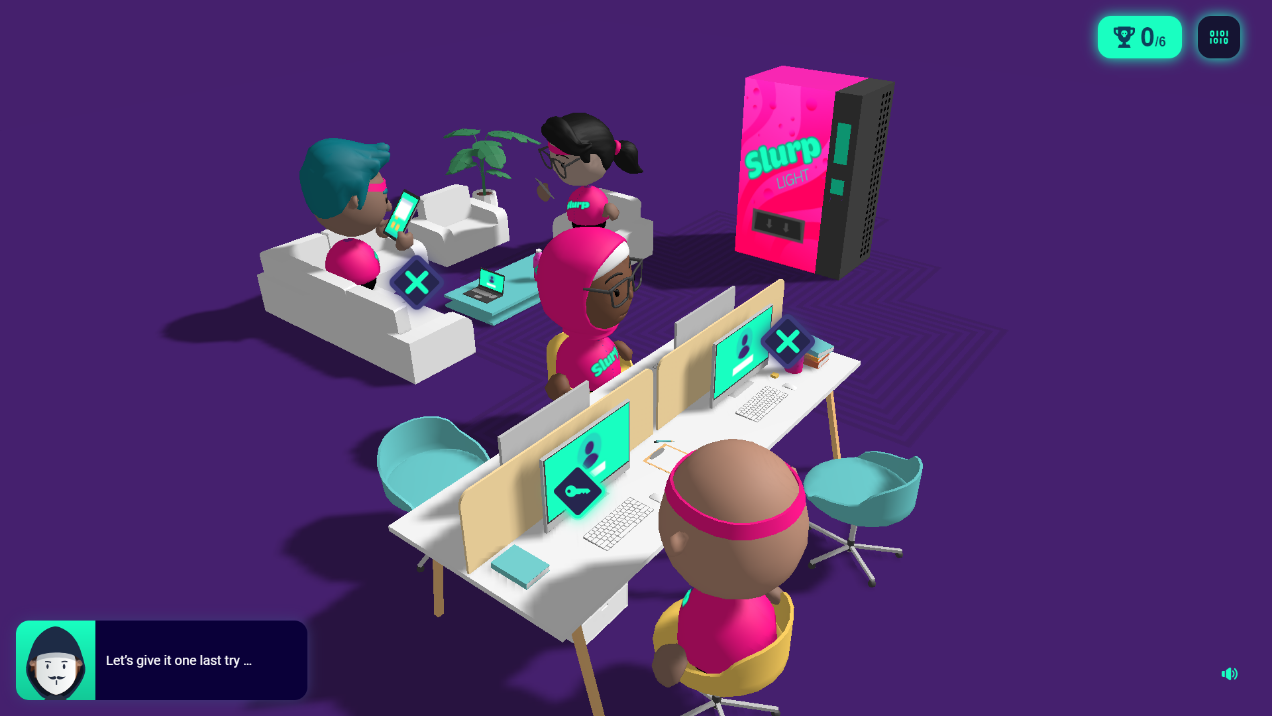
Awareness training: The key to success in preventing cyber attacks
There are two types of companies: those which have already been hacked, and those that will be hacked in the future.
Mobile data, free internet access and remote work make us flexible – and a target for attacks. Cyber criminality is on the rise. Gone are the days where only a handful of hackers tried to obtain our data and – sadly – our money.
To protect themselves, companies must establish effective IT security management. Simply implementing technical measures is no longer enough. The human factor – each company employee – is the most crucial component for successful IT security. Awareness training can be leveraged to sensitise employees to the dangers of cyber-attacks: Knowing about potential dangers helps to stave off criminal hackers.

Cybercrime comes in many forms
A hacker need not have programming skills. Social hacking, for example, involves the perpetrator calling selected persons, asking them for their password for ostensible reasons. If the victim actually reveals their password, psychological and linguistic tricks are employed. The technical skills one would typically connect with the term “hacking” are not used.
This makes it even more important to sensitise staff to such threats – they are dealing with a vast array of them. Few people know offhand what malware, ransomware, identity fraud, phishing or social engineering is all about.

Roman Muth, Security Officer and director of cloud solutions and architecture, imc AG
But wait a minute! Not only big enterprises and publicly listed corporations are potential victims, Roman Muth, Security Officer for Cloud Solution and Architecture at imc AG shares: “Recently, SMEs have often been targeted by cyber criminality, since large corporations tend to be better protected these days. However, the tactics are similar. The masterminds first approach employees to identify vulnerabilities and obtain information they can use to damage the company, and maybe even blackmail it and extort money.”
Creating awareness through gamified learning
To create a lasting impact, employee training needs to start with sensitising employees and creating awareness.
No matter how abstract the subject, training needs to do two things to be fully absorbed and understood by the participants: It must capture their attention and show how it is relevant for their day-to-day work. Theoretical constructs that seem foreign to employees and have little to do with their reality at work are forgotten before they even click the final tab.
That is why imc developed an awareness game: to help learners grasp the issue while motivating them to dive deeper into IT security.
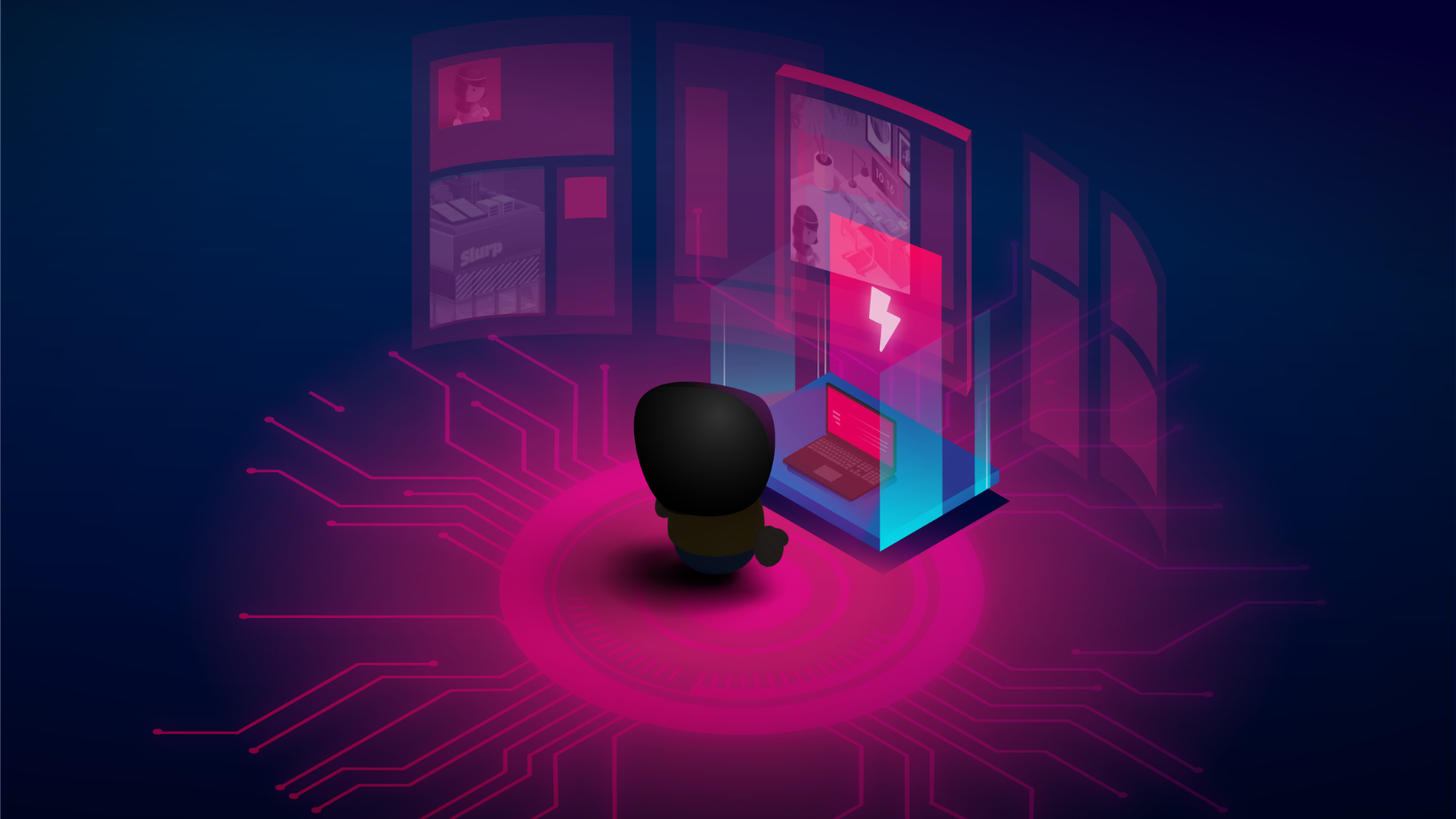
Cyber Crime Time lets the learner slip into the role of a hacker. Step by step, they learn the most common cyber-attacks first hand. The learner – or hacker – gradually adds to their “hacker toolkit” to obtain secret information through the employees of a fictional company.
Once their personal ambition to hack this company and fulfil the secretive client’s order is aroused, the most important rules for preventing cyber-attacks are virtually picked up by the way.

GOOD TO KNOW
Cyber Crime Time can be integrated into any Learning Management System (LMS) and added to the corporate standard training package. A personal hacker experience is also possible without LMS integration: The online version can be played on any device and is even available free of charge on a single-user licence.

Gamification takes corporate learning to a new level
The fact that Game Based Learning works as a motivational booster for e-learning is already rooted in childhood. We have summarized the most common types of games and practical examples of possible applications for you.

Computer Games in Professional Development
Competence transfer thanks to digital games? It's possible! In an interview with Çiğdem Uzunoğlu, we explain how computer games and continuing education fit together and how they can be used effectively.
Contact Person
I joined the imc newsroom team in 2021. As a journalist my heart beats for content and storytelling.
I’m excited to figure out how e-learing and digitization affect the future of work. My task is to create content to talk about and I’m always looking for trends.
Privately I love to travel and eat Tapas.
Topics: E-Learning Trends, Corporate Social Responsibility, Press and Influencer Relations, New Work

Six vital modules for every digital onboarding concept
A blueprint for efficient onboarding with lasting impact
Different companies have different requirements for their onboarding process. They might want to use modular and future-proof concepts, achieve cost and time savings compared to current approaches, or enable employees to start working sooner. Moreover, the pandemic has accelerated the need for digital onboarding as face-to-face training has not been possible. Despite the pandemic introducing more relaxed, remote working arrangements, hybrid work arrangements will become the norm; hence digital onboarding will become the tool to deliver a great first experience to new employees.
Yet, companies are not the only stakeholders – Employees have their own expectations of the onboarding process. This is why many HR managers are deciding on learner-centric onboarding that revolves around the needs of new employees:
“I want to know what makes my company tick,” – “I want to feel like I’m becoming part of the community,” – “I want to improve my skills.”
To achieve that, your onboarding needs a framework that provides guidance and an emotional connection while assessing the current state of knowledge and developing expertise.
This article explains how to design an exciting and creative digital onboarding process with new and existing e-learning content, even without a learning management system (LMS).

An illustration of the key building blocks
Our experts are always developing concepts suitable for a wide range of requirements. Get a head start with our “best of” compilation. Let’s imagine this situation: You want to digitise five days of basic training that has always been conducted on site. You are looking at a very diverse group of participants. The target group for this training extends beyond new colleagues, and also includes “old hands,” as well as some external service providers. They each have a different level of prior knowledge, different hardware, and different levels of access to a learning management system (LMS). Some might not have any access at all.
How do you satisfy them all? The solution is to design a structured framework for digital onboarding. Our experts recommend getting a head start with these 6 modules:
- A central (digital) starting point
- A daily virtual kick-off
- The self-learning phase
- A virtual hands-on workshop
- The online quiz
- A learning diary
Together, these six modules form a foundation. Let’s look at each element separately.
My Digital Onboarding Kit – The modules in detail
The central starting point could, for example, be a browser-based landing page created especially for onboarding, a homepage in the company intranet, a portal page (in the LMS) or an interactive PDF. It is important that the employees can see at a glance what is on the agenda for the day when they arrive for their onboarding. Think of it as a modern timetable. Every new employee needs structure, and an overview page is an easy way to provide that.
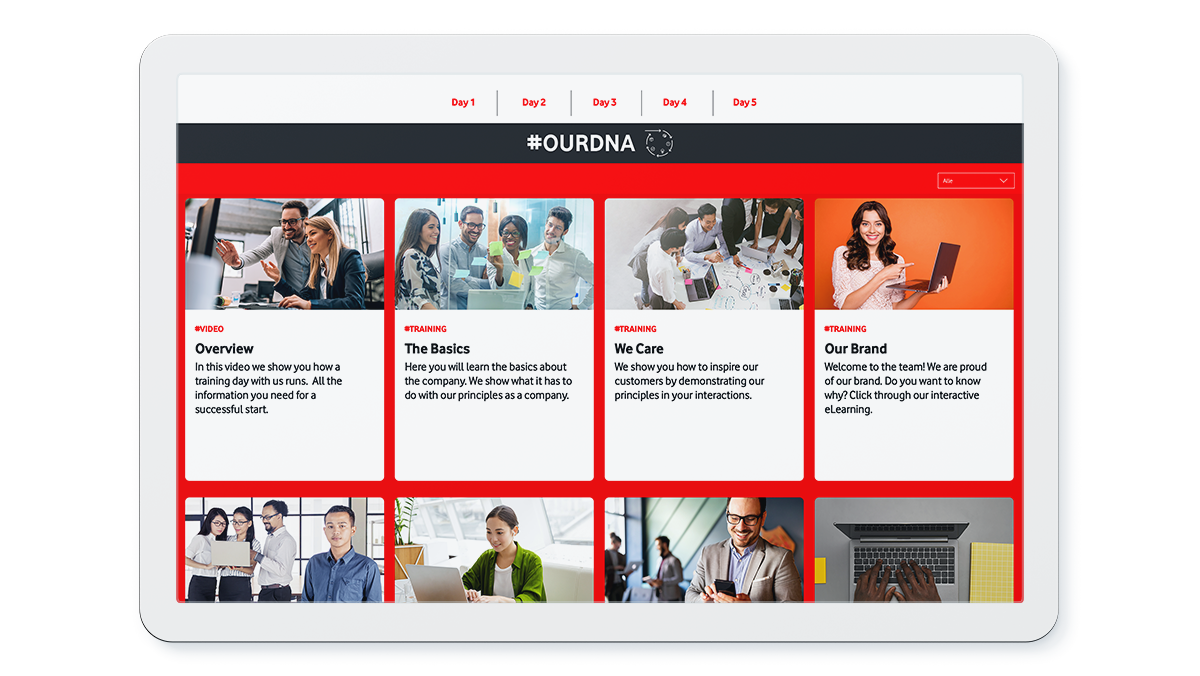
Portal page as central starting point
The virtual kick-off at the beginning of each training day serves to agree and discuss the agenda and objectives for the day together with the trainers. The focus should be on social onboarding, on promoting interaction between the participants. Our experts recommend a playful warm-up with surveys, icebreakers, or activation games aka energisers. Why not play a round of “I packed my bag” to get started? It is helpful to establish a meeting netiquette, specifying that cameras and microphones must be switched on.

virtual kick-off
In the self-learning phase, each learning format achieves a specific objective. For example, digital performance cards help employees gain knowledge with a certain focus, and then apply it in simulations as part of web-based training. Virtual scavenger hunts help them familiarise themselves with the company or the intranet. Companies can also integrate existing training courses or offer individually tailored or branded content. Variation between different e-learning formats has proven particularly effective.
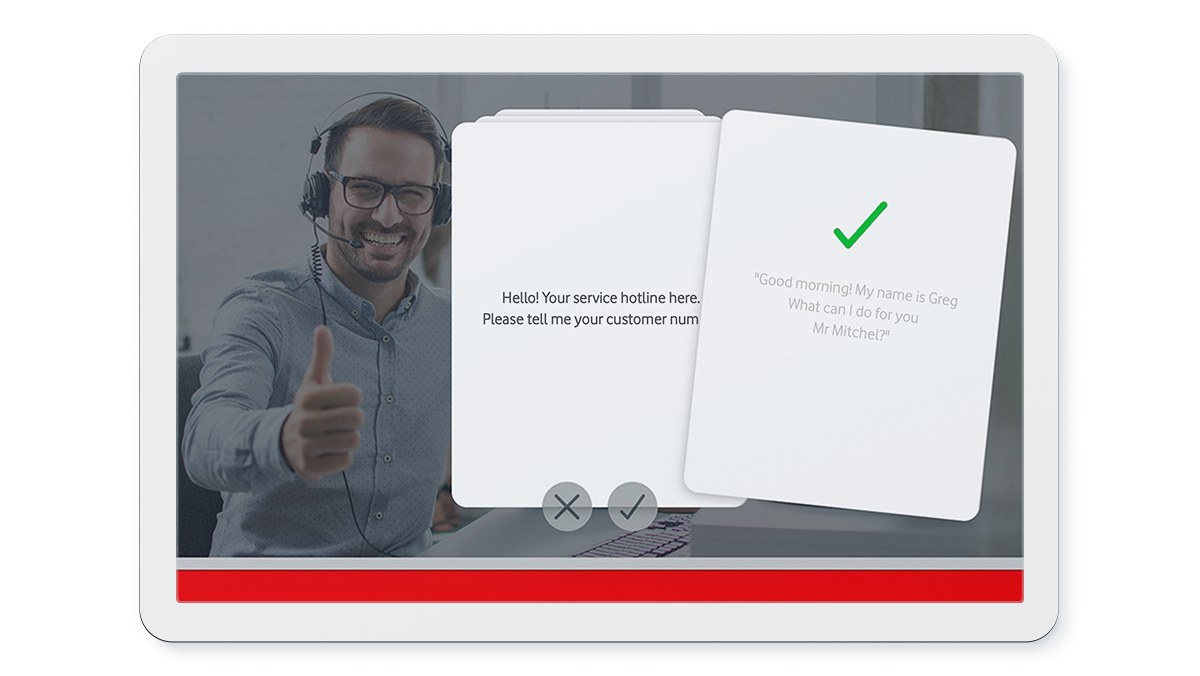
Performance cards
The hands-on workshop moderated by the trainers gives the employees an opportunity to apply what they learned and clarify any questions or uncertainties. This could include polls, multiple choice questions in the group chat or whiteboards.
The online quiz concludes the day. One great example is the BizQuiz. It provides participants with feedback on their learning progress and gives them the opportunity to close any knowledge gaps.
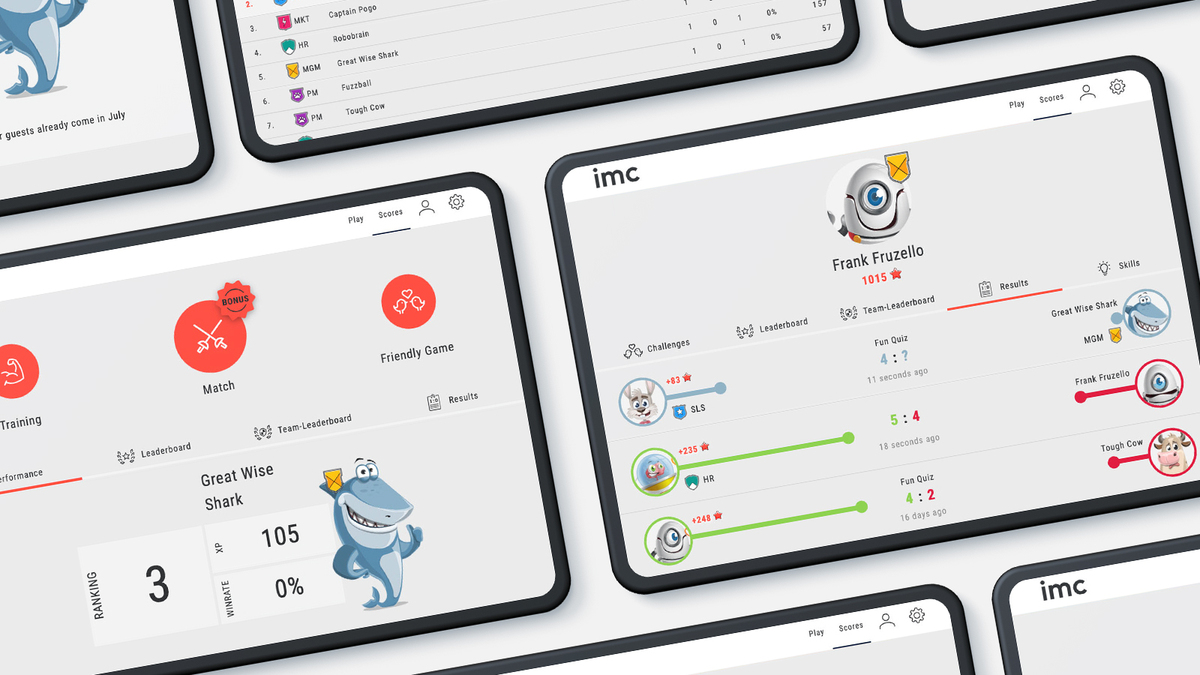
quiz app: Biz Quiz
Finally, the learner makes their personal entry in the learning diary. An easy way to integrate the diary is to design a page in the intranet, a document in the cloud or a form that mirrors the central starting point, and which each participant completes for themselves. This serves to summarise the core messages from the workshops or formulate the questions and tasks for the self-learning phase, as well as compiling key insights from the training courses. The personal learning diary thus becomes an individual reference resource participants can look things up in long after their onboarding.

Learning diary
GOOD TO KNOW
Time investment for trainers is automatically reduced
The targeted use of digital learning formats in the self-learning phase reduces time investment for trainers during digital onboarding. That saves costs and resources. Following this 6-module approach, trainers are only required for the kick-off and the workshop phase.
Digital vs hybrid onboarding
Digital onboarding works. This approach can absolutely be appropriate while also saving resources. Nevertheless, some onboarding processes are easier to realise in a hybrid format. Of course, that does require new employees to travel to the location.
One example for a good hybrid solution would be to communicate theoretical content through online self-study, and then bring participants on site to carry out specific actions, such as operating machinery. The face-to-face part of the training can then be utilised for practical exercises and to clarify questions.
Similarly, a dual approach helps with understanding the corporate culture. For instance, companies might invite new employees for an intro day before their first day of work. Make the most of this day by asking colleagues to talk about how they realise the values, objectives, and mission of the company in their daily work. This meeting can also be leveraged to establish an emotional connection with new recruits and build enthusiasm for the company.
In our experts’ experience, it is not as clear-cut as one approach being universally better. Rather, it is about selecting suitable formats and linking them in a helpful way based on the new employees’ needs and the learning objectives.
We linked a special treat for anyone interested in hybrid onboarding:

Digital Learning Journey
Reaching the destination with the right blend of formats: Digital learning journeys capitalise on the strengths of each learning format to create a motivating learning experience.

LMS Hot Topics: Science fiction or near future?
Onboarding can already be integrated into existing learning management systems. But Hanna's example shows that this is only the beginning.

Contact person
I joined the imc newsroom team in 2021. As a journalist my heart beats for content and storytelling.
I’m excited to figure out how e-learing and digitization affect the future of work. My task is to create content to talk about and I’m always looking for trends.
Privately I love to travel and eat Tapas.
Topics: E-Learning Trends, Corporate Social Responsibility, Press and Influencer Relations
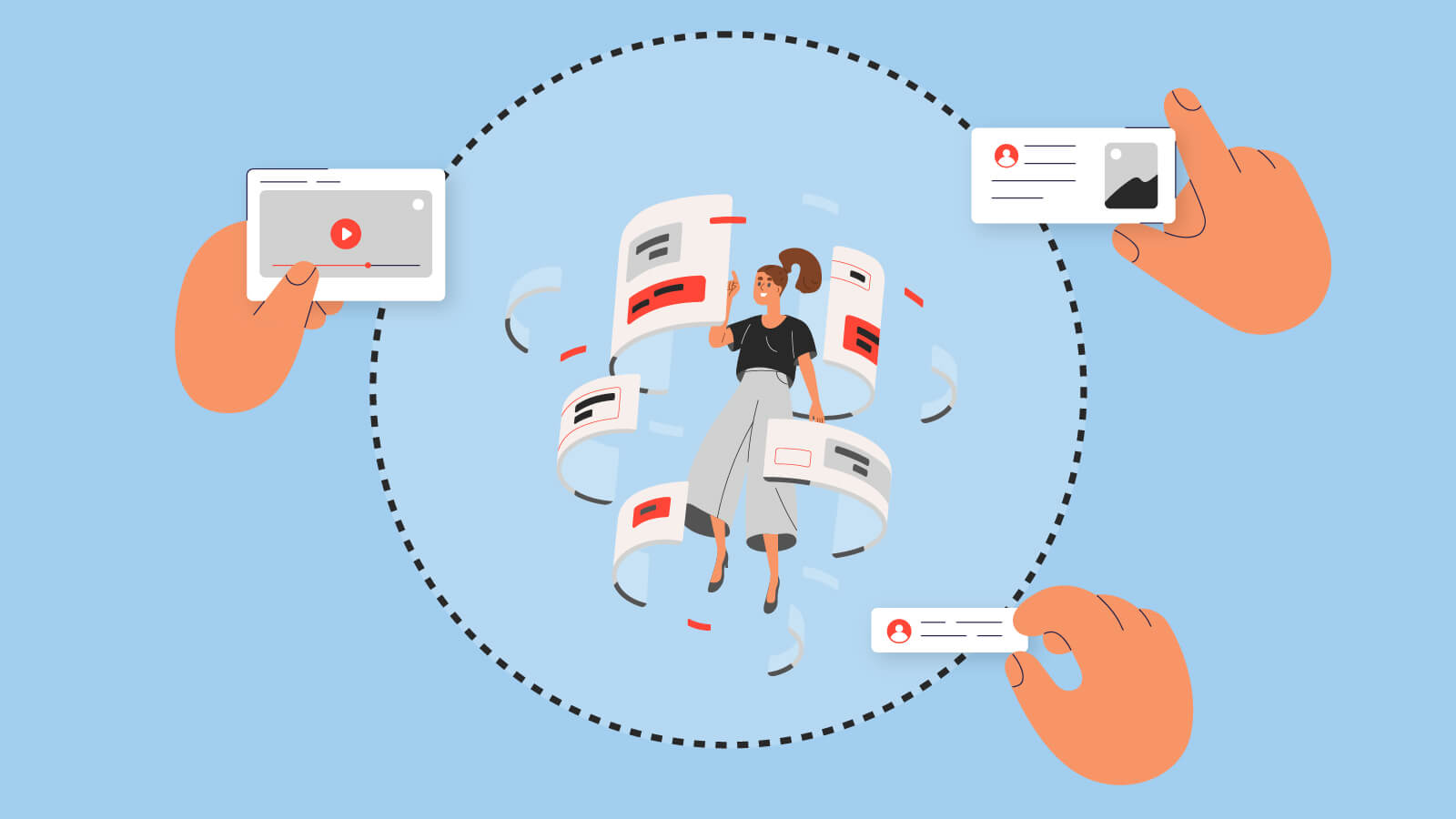
Design thinking with a human perspective
When done well, human-centred design can resonate deeply with its audience. We're looking into the importance of using this technique in e-learning and how it can look like in a practical example from Australia.
Have you ever heard the term human-centred design and wondered what it meant? Well, in a nutshell it describes the design of e-learning solutions that focus on placing learners in situations they experience every day.
Imagining human-centred design
Human-centred design works by actually imagining the experience of work, learning, and problem-solving from the perspective of the employee. Also known as user-driven design and design-thinking, the idea is to build e-learning content with the user in mind by asking them what they want.

How effective is this?
For human-centred design to be effective, e-learning designers must set aside any preconceived ideas they have about how things should work, how learners “should” do things, or what they “should“ know. These assumptions need to be replaced a deeper understanding of their actual experience.
How should a designer do this? Well, the easy answer is to observe and research.
What do human-centred design observation and research look like?
The effective observation and research to successfully capture the human-centred approach are quite simple. Designers would need to consult and collaborate with the end-user. They would need to immerse themselves in the world of an employee, engage with them, ask them questions, get to know their work environment, watch them work to gain an accurate understanding of what it is like to be in their shoes.
For human-centred design to work well, it requires a holistic “hands-on approach” to understand how employees approach their work and why they do things the way they do.
The steps of human-centred design
After consulting with the employees to understand their specific needs, a designer would draft a ‘finished enough to test’ plan of the e-learning course.
The next stage would be to hold a video conference with users and walk them through the plan, taking in any feedback they may have. Once feedback has been incorporated, the building of the e-learning course will take place. After this, designers would need to have the users test it again.
Basically, these last few steps would be repeated until the e-learning content is refined enough that it is ready for publication!
A practical example: State of Victoria meets imc
The imc team utilised the human-centred design approach to find a solution for the onboarding of new staff to the Victorian Department of Health and Human Services (DHHS). With collaborations and workshops, we worked closely with the client and their subject matter experts to understand what separates DHHS and makes them a leading workplace for new employees.
The main aim of this module was to make new starters feel connected to the organisation, their role and how they are part of the bigger picture for DHHS.
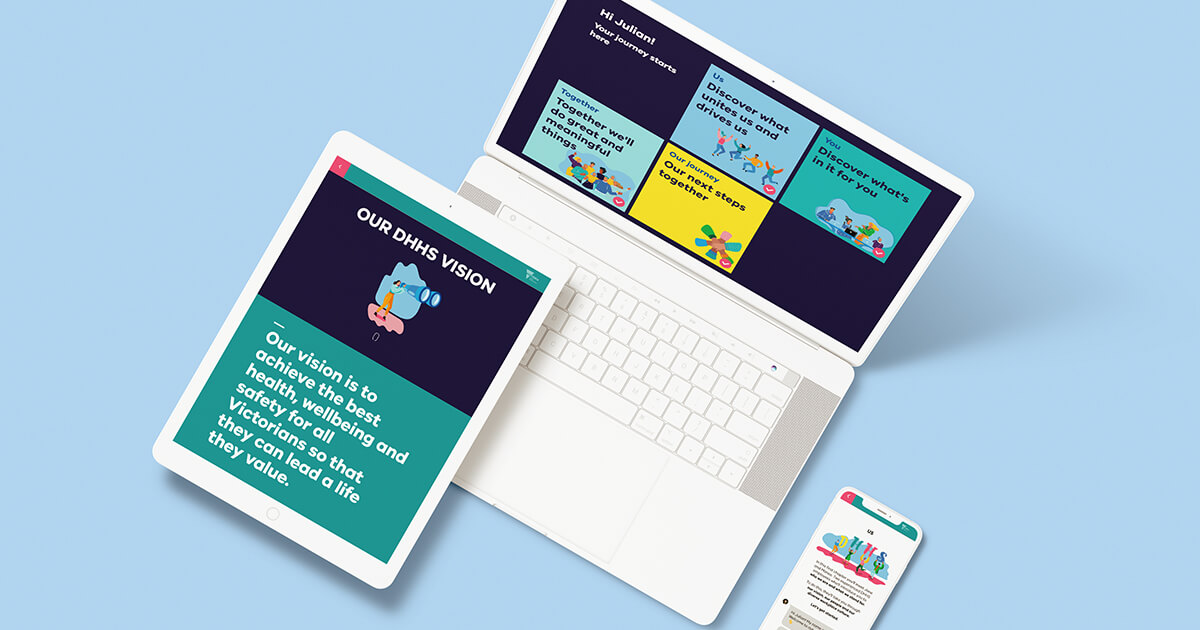
A human-centred solution
Through fresh, modern design and chatbot interactivities, we created a module that welcomes a new employee to the DHHS on an organisational and cultural level in an inviting, warm and friendly way.
Employees can now navigate through human-centred modules using computers, tablets or mobile as it is optimised for all platforms.
Focus on the learner, please!
For us to really understand and empathise with our learners, we need to be talking directly to our target audience as best we can.
Too often, e-learning can make the mistake of focusing on the training itself rather than the target audience.
By going out into the field and meeting with our learners, the human-centred design provides the best way possible to build up an accurate representation of the people we are hoping to inform and educate. This, in turn, leads to e-learning content that is both engaging and practical.
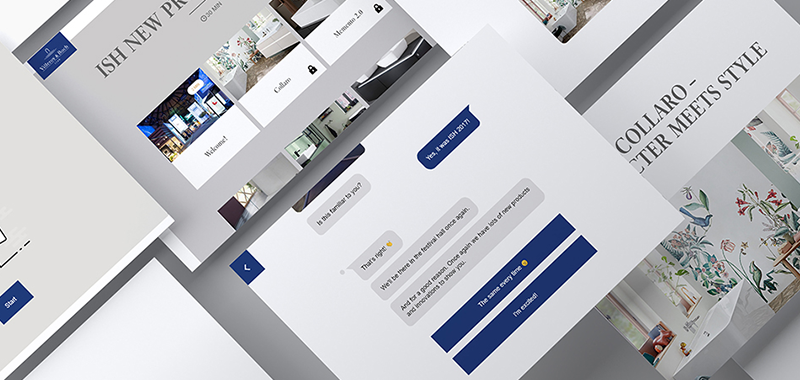
Conversational Chatbot Learning
Advantages of using chatbot to create interactive learning experience.
Contact


Rapid Content Development: Creating E-Learning Trainings Quickly
Why fast creating digital trainings is possible but risky
... and suddenly, the training had to be scrapped. Many companies made that experience in lockdown number one. Employees needed to be trained, but the training was postponed due to Corona. Again. And again. However, most types of training simply cannot be endlessly postponed or even be cancelled altogether.
A pragmatic and swift solution is needed – training needs go where the employees are: their home office. For many companies, that means digitising learning content, and doing so quickly. They need rapid content development. This trend was already apparent before Corona, but the pandemic greatly increased the demand for the technologies that facilitate rapid content development.
This article explores what qualifies as rapid content development, what type of learning content is suitable for rapid digitisation, and what risks a strong focus on speed entails.
INFO
Definition: Rapid content development (RCD) is an agile model for teaching system design, comprising a preparation phase, an iterative design, template-based re-usable components and e-learning tools for quick and cost-efficient provision.
Speedy please – but without quality loss
We want things now: fast food, coffee to go, messenger services, online shopping … we no longer have time. Companies have also clocked onto this trend, and want to stay up to date with their training courses. An ever-increasing amount of knowledge is expected to be available almost instantly on various media while maintaining a high quality standard and staying within budget.
The solution: rapid content development. But wait a minute! No matter how fast you go, the quality of the overall learning solution must not be compromised. That’s why learning experts like Eva Lettenbauer always look at the big picture.

Eva Lettenbauer, Specialist Learning Experience Design at imc
Hi Eva, thanks for “quickly” making time for us. How did you experience the rapid content development hype last year?
Especially at the beginning of the pandemic, many companies were facing the challenge of having to digitalise their face-to-face training in a short space of time. However, directly transitioning classroom-based training courses to a virtual classroom or web session is not always effective, and it’s most certainly not efficient.
That is why we always examine the specific issues and objectives. This allows us to digitise specific learning content in a way that drives outcomes and boosts performance.
How do you handle requests for “rapid” content?
Since requirements differ as widely as the type of knowledge to be conveyed, digital solutions vary enormously. We start by analysing the sharable knowledge and the desired outcome. We also examine if the integration of certain existing learning solutions or curated content would add value, and examine the suitability of different learning infrastructures. Finding the right formats for the content at hand has to be a priority, as this then allows new content to be created quickly and systematically.
What risks does rapid content development involve, and how do you avoid them?
There is a risk of quality loss – creating too much content while neglecting quality, or losing sight of the target group, their performance or the intended business outcome when designing and creating content. This can make the learning solution irrelevant and ineffective. Often, less is more. It pays to take a closer look and be more deliberate when starting the rapid content development process, and avoid such mistakes.

When would you recommend slowing down?
Whenever learning corresponds to behavioural changes, aims to change the learners’ mindset, or the branding, look or feel of the learning solution are important, investing time to achieve a high-quality solution is paramount. This is the only way to gain the learners’ lasting interest and make them believe in digital learning approaches.
GOOD TO KNOW
Authoring tools enable companies to create learning content themselves or digitise existing material. This facilitates a flexible response to learning requirements within the company.
Authoring tools are cost-effective and allow both internal experts and other employees to create training courses. This is also known as user generated content.
What are the limits for content creation with authoring tools?
Authoring tools like imcExpress are ideal for quickly creating and sharing content based on facts or background knowledge. Digital learning content can be created quickly and – crucially – kept up to date. However, no learner should be trained exclusively with web-based training courses. Especially if their development involves the application of specific practical skills, traditional web-based training is seldom enough – but that is all an authoring tool can deliver.
What would a worst-case scenario look like? How “not to” do it?
Worst case: 5 days of face-to-face classroom training is taken “as is” and squeezed into a 3-day training course in a virtual classroom. Endless recordings of face-to-face training or web sessions replace the on-site presentation of the material.
Best case: A 3-day face-to-face training course is digitalised and broken up into various learning nuggets like short web-based training courses, complemented with learning tandems, snappy web sessions and curated content.
How about a quick summary? Happy to be at your service:
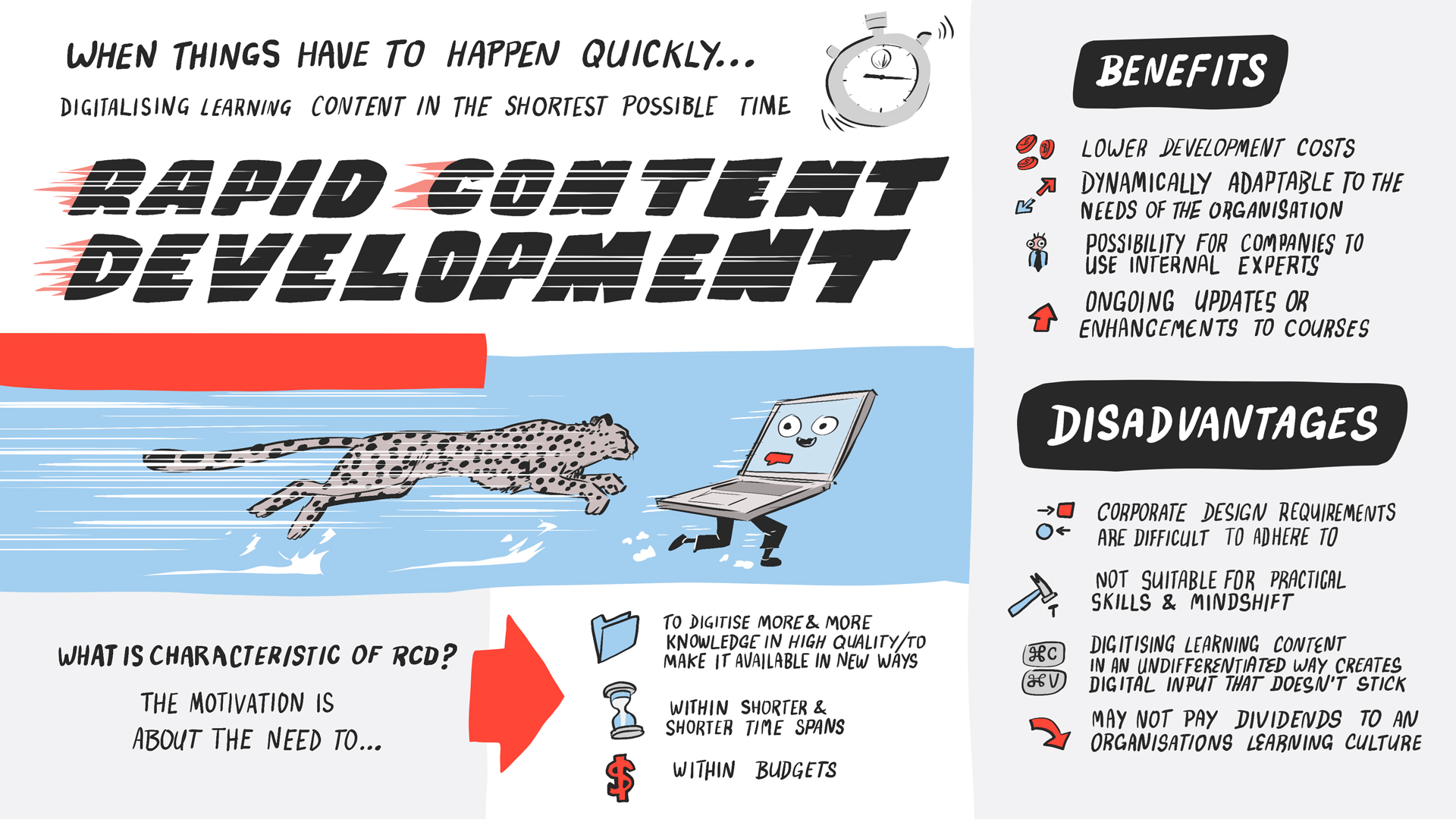

Digital Learning Journey
Reaching the destination with the right blend of formats: Digital learning journeys capitalise on the strengths of each learning format to create a motivating learning experience.

User-generated elearning content meets artificial intelligence
Creating learning content has nerver been that easy. Oliver Nussbaum and his team developed a new AI-driven authoring tool called imc Express.

Contact person
I joined the imc newsroom team in 2021. As a journalist my heart beats for content and storytelling.
I’m excited to figure out how e-learing and digitization affect the future of work. My task is to create content to talk about and I’m always looking for trends.
Privately I love to travel and eat Tapas.
Topics: E-Learning Trends, Corporate Social Responsibility, Press and Influencer Relations

On the podium thanks to e-learning: why sports clubs and associations should focus on digitalisation
After the Olympics is before the next Rugby League, is before the FIFA World Cup! Or vice versa. Regardless of discipline: Training is not only essential for the professional athletes and players, but their trainers, referees and crew members also need continuous professional development.
Summertime is Sports Time! But no matter if watching Tennis, Rugby or Athletics: physical effort and mental training is not the only one. Behind every successful athlete is an entire association and a team that also needs to train and continue learning.
This ranges from new training methods through first aid courses to preventive approaches and anti-doping training – and everything in between. We spoke to a former pro athlete, and explain how these and other topics can be presented as e-learning contents, and what advantages that brings.

Going for gold with blended learning

Eric Uder
Clubs and associations increasingly facilitate continuous development through e-learning, as imc Solution Consultant and former professional javelin thrower Eric Uder notes: “The associations need to ensure that training courses on new training methods, referee rulebooks and preventive approaches are carried out and understood.
Pure face-to-face training is not always helpful in this context. Rather, more and more sports associations from a vast range of disciplines favour blended training concepts, combining e-learning with on-site training.”
No chance for a second Wembley goal
According to Uder, sports associations utilising e-learning is nothing new in itself. After all, the integration of the digital and analogue world has long arrived in sports. That also includes using goal-line technology in football to verify precisely whether or not the ball was in. We can therefore rest assured that we won’t see another Wembley goal.
Moving training scenarios from a face-to-face format to an online environment is thus an obvious solution. Even associations which long resisted this step are now coming around to it, as Uder explains: “We have been supporting larger associations from New Zealand and Australia for years; for instance, in rugby. We now see that the German associations too are increasingly interested in online training concepts and our platform.”

New training scenarios tap into new target groups
With the introduction of a learning platform or learning management system, associations open up far more opportunities than simply training the trainers and referees: Volunteers can gain access and complete mandatory training courses or inductions online, at any time and from anywhere.
It is also easy to include sponsors, keep them informed and offer them insights into current affairs, new regulations, and other items of interest. The possibilities are endless. All types of content can be accessed smoothly without jumping through hoops: from video tutorials, through web-based training to learning nuggets, from compliance through anti-doping to mental health topics.

Excuses are so yesterday
Uder predicts: “I believe that sports associations will place an even stronger focus on digital learning platforms in coming years. They are facing enormous challenges: On the one hand, they are expected to produce results. On the other hand, they are often short staffed and lack financial resources. This makes healthy budgeting practices even more important.
An LMS allows them to send out automated reminders for training courses, book entire groups of members onto new courses at once, or integrate tests to verify that participants have understood the contents. This all saves time while enhancing transparency. It makes it easy to verify who completed which training course when.”
This may well be the knockout punch for excuses claiming ignorance on rules. Maybe, it will even allow us to experience what we crave the most: Sports successes the entire team, as well as the associations and fans can celebrate without reservation.

Don't call it compliance!
Compliance training - the term alone is a red flag for many employees. We give some tips how to create an interesting training instead.

Why the gains from an LMS outweigh its costs
A Learning Management is far too expensive? Not if you use it in the right way! Even more: For most clients, an LMS pays for itself within a year. We tell you how to prove that with a Business Case.
Contact person
I have been working in the Marketing & Communication Team at imc since March 2019.
Communication, creative content and social media are my passion. "KISS - Keep it short and simple" is my credo.
To explain complex content in an understandable way and thus make the topic of e-Learning accessible to everyone is an exciting challenge every day.
Privately I love to read, play poker and travel a lot.
I am always happy to receive feedback or suggestions.
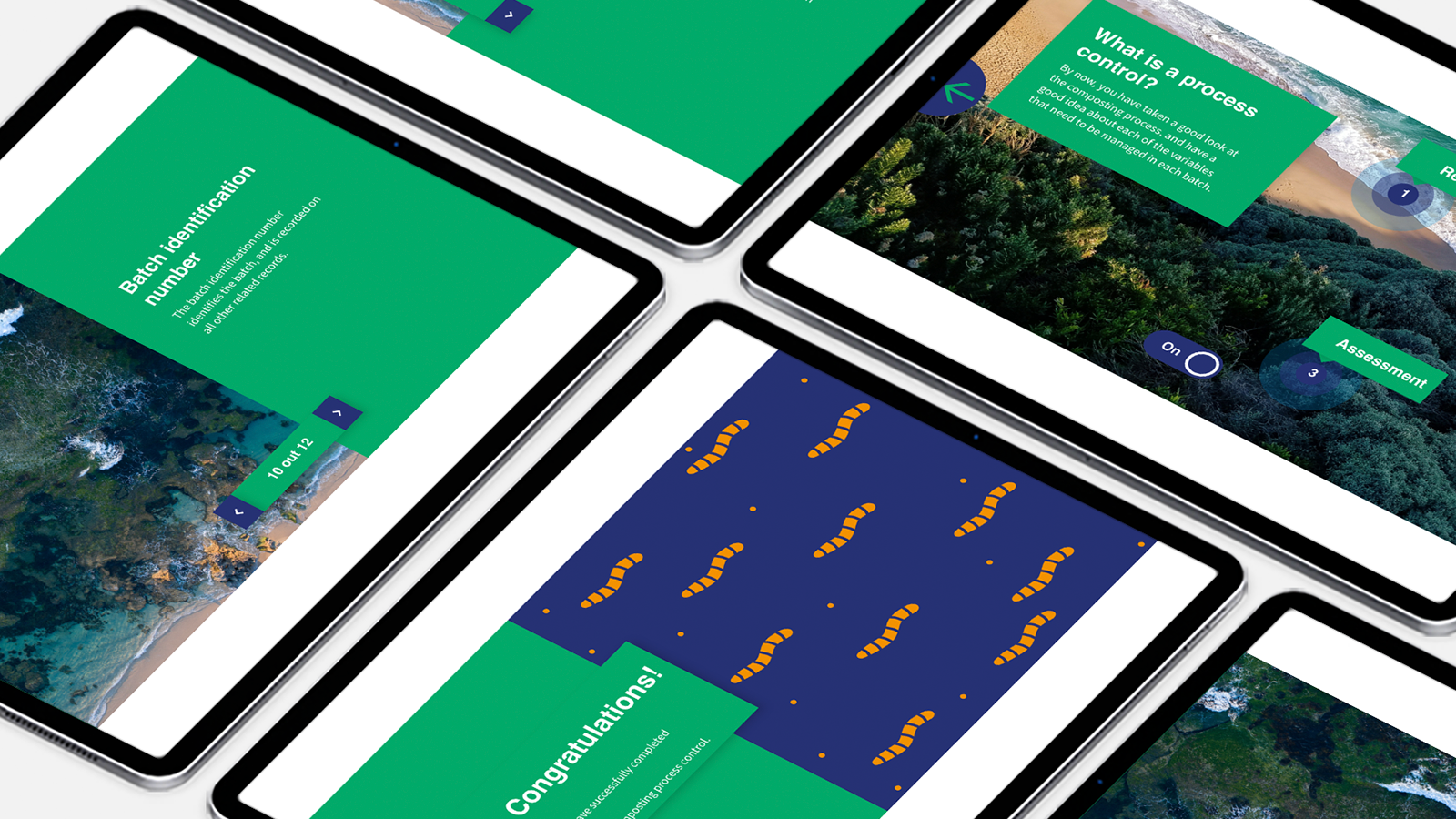
Learning with chatbots
Chatbots have advanced so far that it can sometimes be harder to distinguish between robots and humans. Learn more about how chatbots can be incorporated into corporate training to develop engaged employees.
Chatbots are being increasingly deployed as an important channel of contact. As a tech tool, along with phone and email, plus real human agents, they are becoming a vital point of contact for customers getting in touch with a company.
In addition, it has been used in e-learning content to create an interactive learning experience by using informal languages and creative GIFs. Effective conversational learning with real-time response is one of the advantages of chatbot learning.

Connecting with the consumers using a chatbot
LivePerson’s Consumer Preferences for Conversational Commerce survey found two-thirds of consumers would like to message with brands. Again, this reflects a preference for consumers to do business with companies that answer questions immediately.
Australian consumers are among the highest levels of chatbot users worldwide. Consumers particularly in younger age brackets, are interested in the convenience and ease that chatbot interaction can offer, but they can still be sceptical of bots and prefer human interaction.
However, when developed effectively, chatbots are extremely valuable and can offer a very unique way to forge a connection and develop valuable insights

Chatbots can become a robot teacher
Chatbot learning has evolved because we are now in an age where education has become more accessible than ever. We are constantly in pursuit of better, faster, and deeper ways to learn.
Adult learners are busy and rarely a priority to make time to learn, but utilising chatbot can change this tendency with spikes in productivity because of personable and knowledgeable training assistance.
Additionally, it can offer a welcome change to employees, with interactive training elements to engage them with high knowledge retention and put them in control of their own learning journeys.
What are the benefits of chatbot learning for organisations?
Some of the advantages of incorporating chatbot learning include:
- Real-time analytics dashboards, these measure the most commonly asked questions, track active and engaged learners versus learners who are not engaged, view the interactions that happen during off-hours, and evaluate learners’ skill development.
- They will encourage employees to be more productive and better placed to learn at their own pace when they need support.
- They can push out personalised information to learners.
- They can review and access all learner created questions and responses.
- They reduce the workload of trainers.
How can chatbots be used in corporate e-learning?
Integrating chatbot learning into your Learning Management System (LMS) environment can provide your organisation with additional data about learners.
This will significantly contribute to the process of learning because learners are using an interactive mechanism as compared to traditional e-learning systems. Digital learning with chatbot offers more personalised and effective learning, by giving learners direct access and control to information and learning stored in the LMS.
Let’s Chat Compost
An example of a conversational learning chatbot approach developed by imc Australia was deployed in the New South Wales Environment Protection Authority (EPA). The chatbot complemented the Compost Facility Management Training by teaching learners some of the basics of the main concepts in the e-learning program, such as Odour, Pasteurisation, Contamination and the Composting Process. It was also operating as a driver to motivate participants to want to learn more by going on to complete the Compost Facility Management course.
imc Australia used engaging design (Chatbot framework) and a conversational learning approach to teach participants about technical concepts involved in composting, using an informal and fun approach to gain their interest and inspire them to complete further study on the subject. You can register on the EPA’s learning management system here.
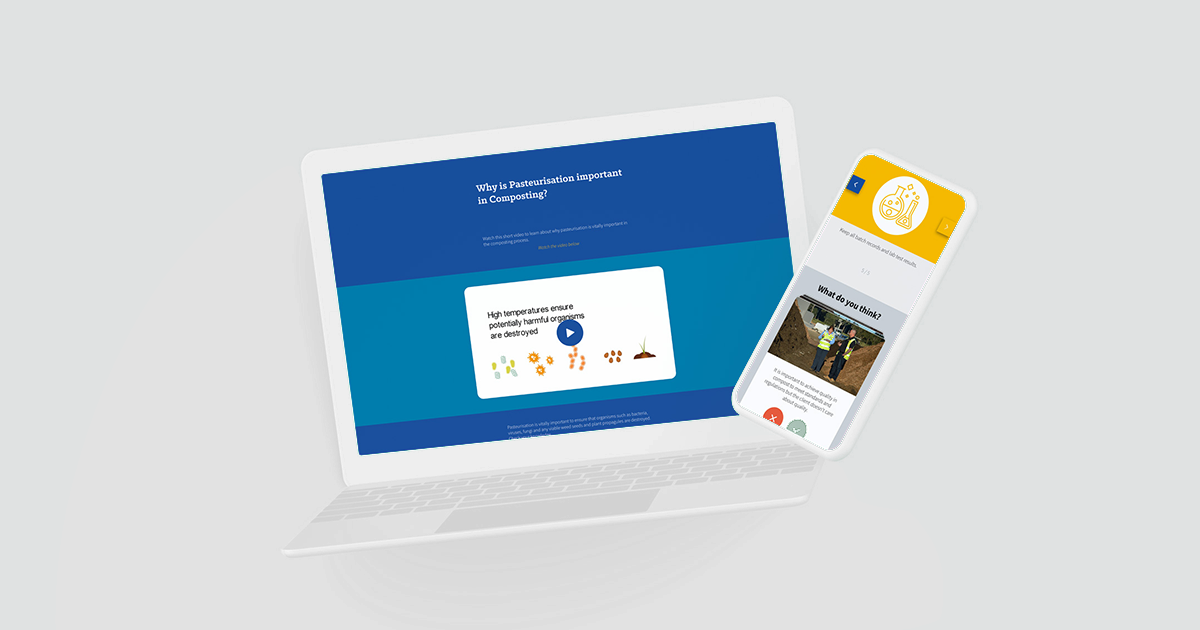
Chatbot learning utilises interactive elements
Moreover, imc created a chatbot that uses more informal language and uses GIFs as well as emojis to make it a more interactive experience for learners.
We have implemented GIFs within our chatbot learning because they can make learning more vivid and entertaining.
Here are some of the benefits of using GIFs in e-learning:
- They visually represent ideas and information in a few seconds
- They are easier to follow than a series of still images
- They usually run in a loop and are also perceived out of the corner of the eye
- They are much easier to create than higher-end video content
- They can play automatically on almost any system
- They trigger emotions. The stronger the emotion, the better the memory
What do chatbots mean for your e-learning
Chatbot learning can make a more productive learning process. It offers a more personalised experience for employees and also makes learning and development departments more efficient.
So, if you want to provide on-the-ball support and real-time personalisation for your learners, make your initiatives more productive and efficient, then a chatbot might be right for your organisation.

Gamified Learning to Drive Learner Motivation
How does gamified learning increase employees' motivation and help them build their skills in the workplace?

Villeroy & Boch Chatbot Learning
A successful chatbot learning combined with web-based training to urgently train 400 sales representatives worldwide.
Contact


